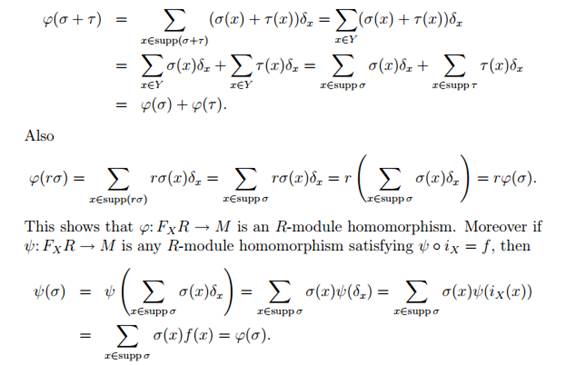
Modules-Construction of Free Modules
 المؤلف:
David R. Wilkins
المؤلف:
David R. Wilkins
 المصدر:
Algebraic Topology
المصدر:
Algebraic Topology
 الجزء والصفحة:
87-89
الجزء والصفحة:
87-89
 2-7-2017
2-7-2017
 1874
1874
Proposition 1.1 Let X be a set, and let R be a unital ring. Then there exists a left R-module FRX and an injective function iX: X → FRX such that FRX is freely generated by iX(X). The R-module FRX and the function iX: X → FRX then satisfy the following universal property:
given any left R-module M, and given any function f: X → M, there exists a unique R-module homomorphism ϕ: FRX → M such that ϕ ◦ iX = f.
The elements of FRX may be represented as functions from X to R that have only finitely many non-zero values. Also given any element x of X, the corresponding element iX(x) of FRX is represented by the function δx: X → R, where δx maps x to the identity element of R, and maps all other elements of X to the zero element of R.
Proof Let 0R and 1R denote the zero element and the multiplicative identity element respectively of the ring R.
We define FRX to be the set of all functions σ: X → R from X to R that have at most finitely many non-zero values.
Note that if σ and τ are functions from X to R that have at most finitely many non-zero values, then so is the sum σ+τ of the functions σ and τ (where (σ + τ )(x) = σ(x) + τ (x) for all x ∈ X). Therefore addition of functions is a binary operation on the set FRX. Moreover FRX is an Abelian group with respect to the operation of addition of functions.
Given r ∈ R, and given σ ∈ FRX, let rσ be the function from X to R defined such that (rσ)(x) = rσ(x) for all x ∈ X. Then
r(σ + τ ) = rσ + rτ, (r + s)σ = rσ + sσ,
(rs)σ = r(sσ), 1Rσ = σ
for all σ, τ ∈ FRX and r, s ∈ R. It follows that FRX is a module over the ring R.
Given x ∈ X, let δx: X → R be the function defined such that

Then δx ∈ FRX for all x ∈ X. We denote by iX: X → FRX the function that sends x to δx for all x ∈ X.
We claim that FRX is freely generated by the set iX(X), where iX(X) = {δx : x ∈ X}. Let M be an R-module, and let f: X → M be a function from X to M. We must prove that there exists a unique R-module homomorphism ϕ: FRX → M such that ϕ ◦ iX = f (Lemma 1.1)in(Free Modules).
Let σ be an element of FRX. Then σ is a function from X to R with at most finitely many non-zero values. Then σ =∑x∈supp σ σ(x)δx, where supp σ = {x ∈ X : σ(x) ≠0R}.
We define ϕ(σ) = ∑x∈supp σ σ(x)f(x). This associates to each element σ of FRX a corresponding element ϕ(σ) of M. We obtain in this way a function ϕ: FRX → M.
Let σ and τ be elements of FRX, let r be an element of the ring R, and let Y be a finite subset of X for which supp σ ⊂ Y and supp τ ⊂ Y . Then supp(σ + τ ) ⊂ Y , and

Thus ϕ: FRX → M is the unique R-module homomorphism satisfying ϕ ◦ iX = f.
It now follows from Lemma 8.5 that the R-module FRX is freely generated by iX(X). We have also shown that the required universal property is satisfied by the module FRX and the function iX.
Definition Let X be a set, and let R be a unital ring. We define the free left R-module on the set X to be the module FRX constructed as described in the proof of Proposition 1.1. Moreover we may consider the set X to be embedded in the free module FRX via the injective function iX: X → FXX described in the statement of that proposition Abelian groups are modules over the ring Z of integers. The construction of free modules therefore associates to any set X a corresponding free Abelian group FZX.
Definition Let X be a set. The free Abelian group on the set X is the module FZX whose elements can be represented as functions from X to Z that have only finitely many non-zero values.
 الاكثر قراءة في التبلوجيا
الاكثر قراءة في التبلوجيا
 اخر الاخبار
اخر الاخبار
اخبار العتبة العباسية المقدسة


